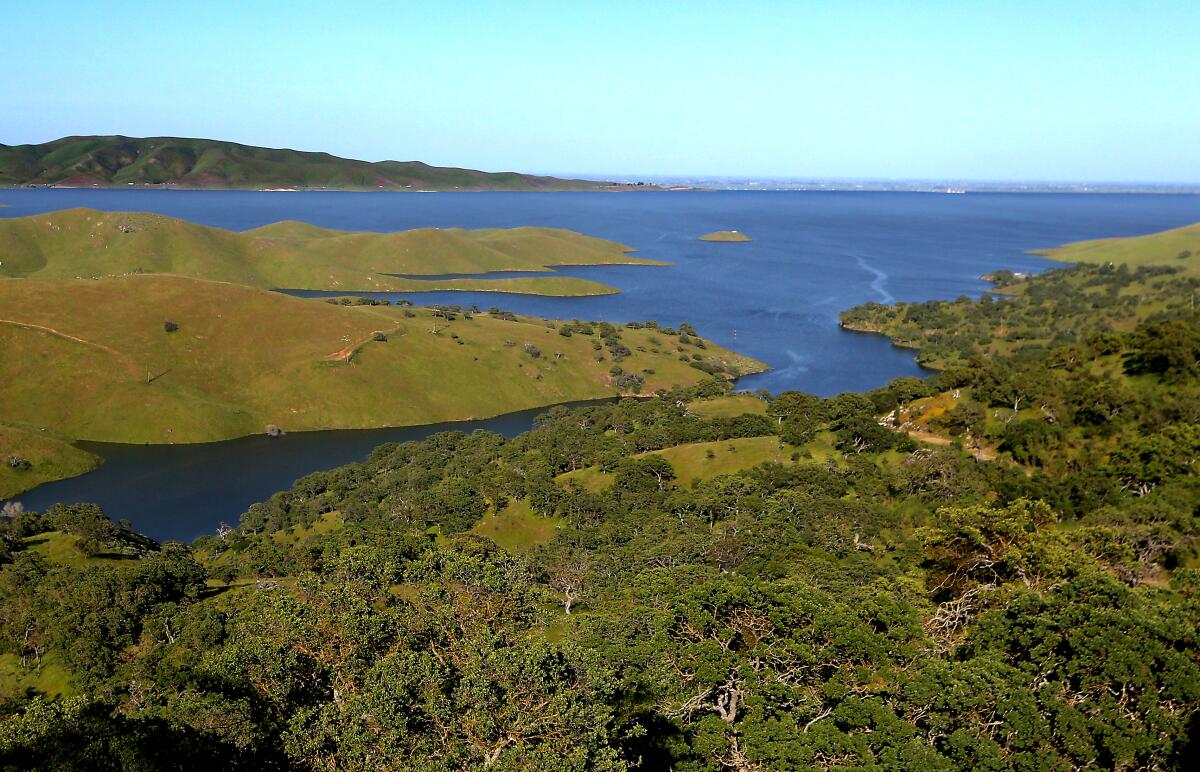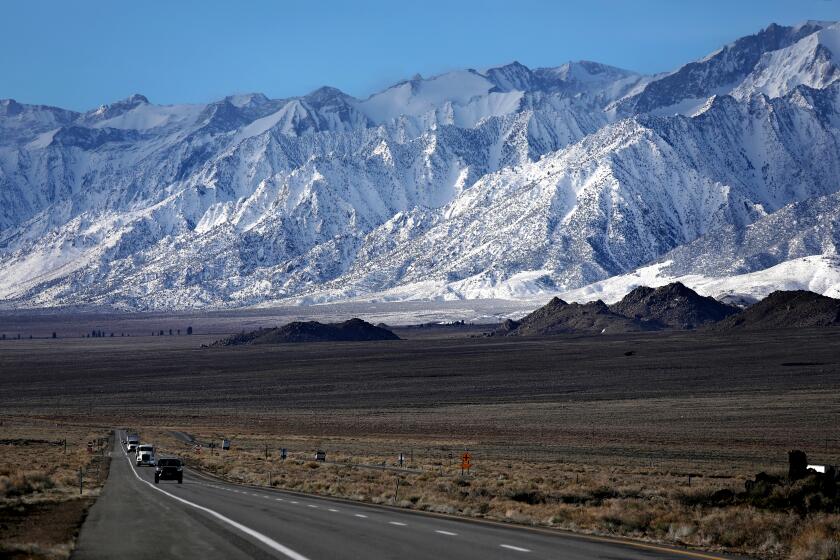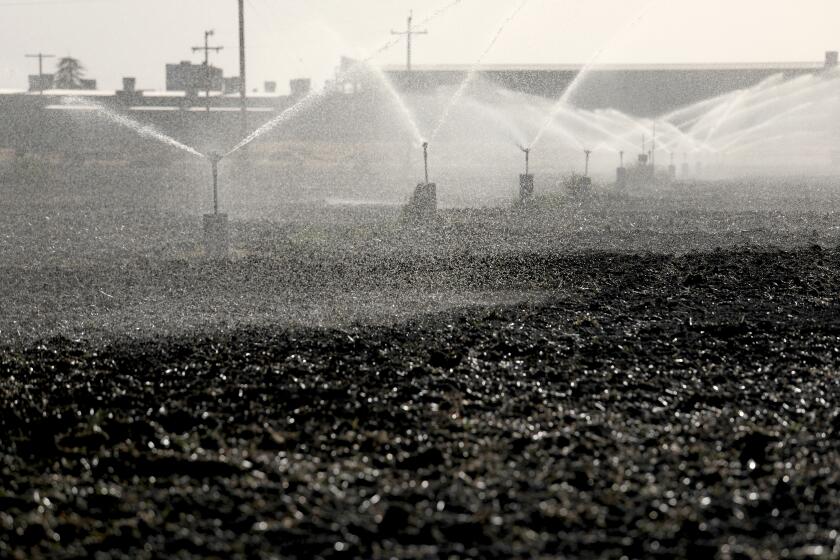A wet California boosts water allocations to 100% for first time in nearly 20 years

- Share via
For the first time since 2006, California officials have increased allocations from the vital State Water Project to 100% of requested supplies, as reservoirs across the state are nearing capacity and an epic snowpack has yet to melt.
An unusually wet winter brought unprecedented snowfall and a succession of heavy rainstorms, pulling much of the state out of a punishing years-long drought and transforming the year’s water outlook.
“It’s the biggest allocation in quite a few years now and it reflects a very, very wet year,” said Jay Lund, professor of civil and environmental engineering at UC Davis. “Even in pretty wet years, we haven’t gotten to 100% allocations.”
Just last year — when the state faced a third season of punishing drought — officials slashed water allocations to 5% for those relying on the State Water Project, a complex system of reservoirs, canals and dams that supplies about 27 million residents and 750,000 acres of farmland.
But this year has been a different story. Record-high snowpack in the Sierra has filled reservoirs to the brim and forecasters have predicted above-average precipitation into early May — two months later than the state’s rainy season typically ends.
Striking photos from space show the Sierra and Southern California mountain ranges beginning to shed their record snowpack as weather warms up.
“With reservoirs nearing capacity and snowmelt runoff starting to occur, [the state Department of Water Resources] now expects to deliver 100% of requested water supplies, up from 75% announced in March,” state officials said Thursday.
Also on Thursday, the U.S. Bureau of Reclamation announced a corresponding increase to 100% of requested water allocations for most regions served by the federal Central Valley Project, which provides critical farming irrigation and water supplies to the San Joaquin Valley, San Francisco Bay Area and Central Valley.
For many of those regions, this will be the first time since 2017 that water allocations have reached 100% of requested supplies.
“Following two years of 0% allocations, this announcement will provide much-needed water to support the [Westlands Water] District’s communities, family-owned farms and hardworking families in the San Joaquin Valley,” said Jose Gutierrez, the interim general manager for the Westlands Water District, a Central Valley Project contractor serving mostly rural communities in Fresno and Kings counties. “This water supply will assist growers in Westlands with putting the land to work to grow the food that feeds the world.”
Being able to fulfill entire water allocations will provide farms some immediate relief, Lund said, but local and state officials still need to think about recharging groundwater as water scarcity is going to be an ongoing issue in California.
“It’s a matter of balancing how much do you grow this year, versus making sure you have enough water ... during those dry years,” Lund said. “This is a good year; store that groundwater while you can because it’s not always going to be this good.”
He said he hopes to see farmers continuing to fallow some of their fields, especially in the southern part of the San Joaquin Valley, where much of the groundwater is depleted.
California’s farm belt needs to tighten up, as there simply will not be enough water to sustain present irrigation in the San Joaquin Valley.
Reservoirs across the state have continued to fill in recent weeks — if not already reaching capacity.
The San Luis Reservoir in Merced County, which holds water for both the State Water Project and the Central Valley Project, was at 99% capacity Thursday, considered full by state water officials. It sat at 36% capacity in early January but has steadily climbed, according to California Department of Water Resources data.
In Southern California, the Cachuma and Castaic reservoirs were at 99% and 96% capacity, respectively.
Lake Oroville in Butte County, which provides the most water to the State Water Project, is expected to be full by the end of May, state water officials said. As of Thursday, it sat at 89% capacity.
Lake Shasta, the flagship reservoir for the Central Valley Project, hit 94% capacity Thursday, continuing to see daily increases.
Overall, state reservoirs are at 105% of their average for this time of year, according to DWR data.
The strong supply has also allowed State Water Project officials to make additional water available to any contractor with available storage — on top of a local provider’s yearly allocation, DWR officials said.
State officials have released preliminary floodoing forecast for the San Joaquin Valley and Tulare Lake Basin due to a historic snowpack.
While flooding remains an ongoing concern across the Central Valley, state and federal water managers said they will continue to monitor reservoirs. But with increasing water distributions and planned releases — for irrigation or salmon — officials said the reservoirs aren’t expected to become flood hazards.
But even in the face of what feels like such an excess of water, Heather Cooley, a water researcher at the Pacific Institute, said it’s important to stay focused on California’s long-term water issues, especially those important groundwater basins that remain dry. Many residents in the Central Valley are still dealing with dry wells, and not everyone gets water from the State Water or Central Valley projects.
In the San Joaquin Valley, 1,800 families rely on state-funded water deliveries to fill household tanks. The list of those waiting for fixes has been growing.
“Even though we are seeing this recharge of surface reservoirs, we still need to use water efficiently,” Cooley said. “The fact that we have water available this year buys us more time, but it doesn’t change the need to make those [long-term] changes in sustainability and resiliency.”
And though California has mostly eased out of drought conditions, the Colorado River Basin — a critical water source for Southern California — remains in a decades-long drought.
“This is a good year; next year — you never know,” Lund said. “It just reminds us that California has some very wet years and some very dry years.”
More to Read
Sign up for Essential California
The most important California stories and recommendations in your inbox every morning.
You may occasionally receive promotional content from the Los Angeles Times.


















